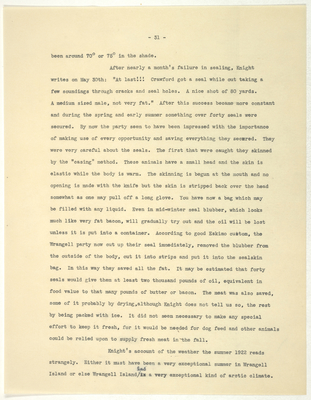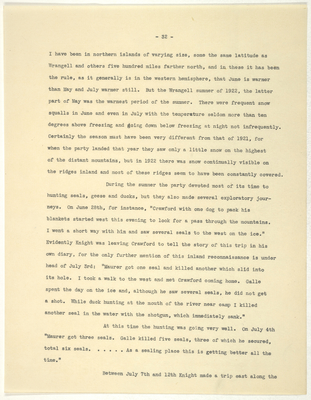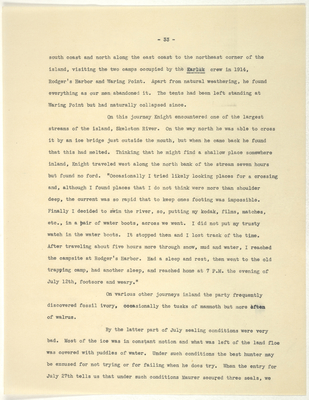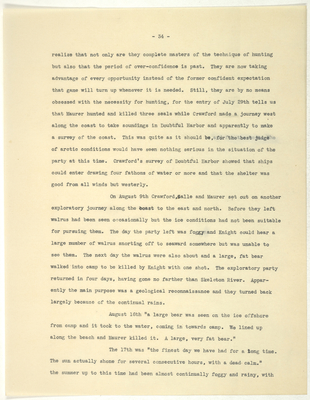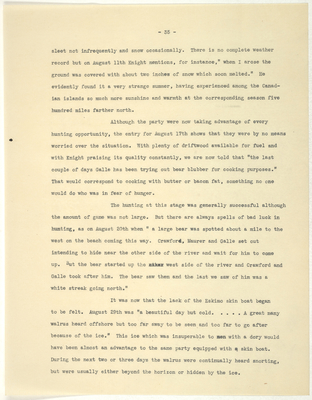Pages
stefansson-wrangel-09-25-006-031
- 31 -
been around 70° or 75° in the shade.
After nearly a month’s failure in sealing, Knight writes on May 30th: "At last!!! Crawford got a seal while out taking a few soundings through cracks and seal holes. A nice shot of 80 yards. A medium sized male, not very fat.” After this success became more constant and during the spring and early summer something over forty seals were secured. By now the party seem to have been impressed with the importance of making use of every opportunity and saving everything they secured. They were very careful about the seals. The first that were caught they skinned by the "casing" method. These animals have a small head and the skin is elastic while the body is warm. The skinning is begun at the mouth and no opening is made with the knife but the skin is stripped back over the head somewhat as one may pull off a long glove. You have now a bag which may be filled with any liquid. Even in mid-winter seal blubber, which looks much like very fat bacon, will gradually try out and the oil will be lost unless it is put into a container. According to good Eskimo custom, the Wrangell party now cut up their seal immediately, removed the blubber from the outside of the body, cut it into strips and put it into the sealskin bag. In this way they saved all the fat. It may be estimated that forty seals would give them at least two thousand pounds of oil, equivalent in food value to that many pounds of butter or bacon. The meat was also saved, some of it probably by drying, although Knight does not tell us so, the rest by being packed with ice. It did not seem necessary to make any special effort to keep it fresh, for it would be needed for dog feed and other animals could be relied upon to supply fresh meat in the fall.
Knight’s account of the weather the summer 1922 reads strangely. Either it must have been a very exceptional summer in Wrangell Island or else Wrangell Island had xx a very exceptional kind of arctic climate.
stefansson-wrangel-09-25-006-032
- 32 -
I have been in northern islands of varying size, some the same latitude as Wrangell and others five hundred miles farther north, and in these it has been the rule, as it generally is in the western hemisphere, that June is warmer than May and July warmer still. But the Wrangell summer of 1922, the latter part of May was the warmest period of the summer. There were frequent snow squalls in June and even in July with the temperature seldom more than ten degrees above freezing and going down below freezing at night not infrequently. Certainly the season must have been very different from that of 1921, for when the party landed that year they saw only a little snow on the highest of the distant mountains, but in 1922 there was snow continually visible on the ridges inland and most of these ridges seem to have been constantly covered.
During the summer the party devoted most of its time to hunting seals, geese and ducks, but they also made several exploratory journeys. On June 28th, for instance, “Crawford with one dog to pack his blankets started west this evening to look for a pass through the mountains. I went a short way with him and saw several seals to the west on the ice." Evidently Knight was leaving Crawford to tell the story of this trip in his own diary, for the only further mention of this inland reconnaissance is under head of July 3rd: "Maurer got one seal and killed another which slid into its hole. I took a walk to the west and met Crawford coming home. Galle spent the day on the ice and, although he saw several seals, he did not get a shot. While duck hunting at the mouth of the river near camp I killed another seal in the water with the shotgun, which immediately sank."
At this time the hunting was going very well. On July 4th "Maurer got three seals. Galle killed five seals, three of which he secured, total six seals. .....As a sealing place this is getting better all the time."
Between July 7th and 12th Knight made a trip east along the
stefansson-wrangel-09-25-006-033
- 33 -
south coast and north along the east coast to the northeast corner of the island, visiting the two camps occupied by the Karluk crew in 1914, Rodger's Harbor and Waring Point. Apart from natural weathering, he found everything as our men abandoned it. The tents had been left standing at Waring Point but had naturally collapsed since.
On this journey Knight encountered one of the largest streams of the island, Skeleton River. On the way north he was able to cross it by an ice bridge just outside the mouth, but when he came back he found that this had melted. Thinking that he might find a shallow place somewhere inland, Knight traveled west along the north bank of the stream seven hours but found no ford. "Occasionally I tried likely looking places for a crossing and, although I found places that I do not think were more than shoulder deep, the current was so rapid that to keep ones footing was impossible. Finally I decided to swim the river, so, putting my kodak, films, matches, etc., in a pair of water boots, across we went. I did not put my trusty watch in the water boots. It stopped then and I lost track of the time. After traveling about five hours more through snow, mud and water, I reached the campsite at Rodger's Harbor. Had a sleep and rest, then went to the old trapping camp, had another sleep, and reached home at 7 P.M. the evening of July 12th, footsore and weary."
On various other journeys inland the party frequently discovered fossil ivory, occasionally the tusks of mammoth but more often of walrus.
By the latter part of July sealing conditions were very bad. Most of the ice was in constant motion and what was left of the land floe was covered with puddles of water. Under such conditions the best hunter may be excused for not trying or for failing when he does try. When the entry for July 27th tells us that under such conditions Maurer secured three seals, we
stefansson-wrangel-09-25-006-034
- 34 -
realize that not only are they complete masters of the technique of hunting but also that the period of over-confidence is past. They are now taking advantage of every opportunity instead of the former confident expectation that game will turn up whenever it is needed. Still, they are by no means obsessed with the necessity for hunting, for the entry of July 29th tells us that Maurer hunted and killed three seals while Crawford made a journey west along the coast to take soundings in Doubtful Harbor and apparently to make a survey of the coast. This was quite as it should be, for the best judge of arctic conditions would have seen nothing serious in the situation of the party at this time. Crawford’s survey of Doubtful Harbor showed that ships could enter drawing four fathoms of water or more and that the shelter was good from all winds but westerly.
On August 9th Crawford, Galle and Maurer set out on another exploratory journey along the coast to the east and north. Before they left walrus had been seen occasionally but the ice conditions had not been suitable for pursuing them. The day the party left was foggy and Knight could hear a large number of walrus snorting off to seaward somewhere but was unable to see them. The next day the walrus were also about and a large, fat bear walked into camp to be killed by Knight with one shot. The exploratory party returned in four days, having gone no farther than Skeleton River. Apparently the main purpose was a geological reconnaissance and they turned back largely because of the continual rains.
August 16th "a large bear was seen on the ice offshore from camp and it took to the water, coming in towards camp. We lined up along the beach and Maurer killed it. A large, very fat bear."
The 17th was "the finest day we have had for a long time. The sun actually shone for several consecutive hours, with a dead calm." the summer up to this time had been almost continually foggy and rainy, with
stefansson-wrangel-09-25-006-035
- 35 -
sleet not infrequently and snow occasionally. There is no complete weather record but on August 11th Knight mentions, for instance, "when I arose the ground was covered with about two inches of snow which soon melted." He evidently found it a very strange summer, having experienced among the Canadian islands so much more sunshine and warmth at the corresponding season five hundred miles farther north.
Although the party were now taking advantage of every hunting opportunity, the entry for August 17th shows that they were by no means worried over the situation. With plenty of driftwood available for fuel and with Knight praising its quality constantly, we are now told that "the last couple of days Galle has been trying out bear blubber for cooking purposes.” That would correspond to cooking with butter or bacon fat, something no one would do who was in fear of hunger.
The hunting at this stage was generally successful although the amount of game was not large. But there are always spells of bad luck in hunting, as on August 20th when "a large bear was spotted about a mile to the west on the beach coming this way. Crawford, Maurer and Galle set out intending to hide near the other side of the river and wait for him to come up. But the bear started up the xxxxx west side of the river and Crawford and Galle took after him. The bear saw them and the last we saw of him was a white streak going north."
It was now that the lack of the Eskimo skin boat began to be felt. August 29th was "a beautiful day but cold. .... A great many walrus heard offshore but too far away to be seen and too far to go after because of the ice." This ice which was insuperable to men with a dory would have been almost an advantage to the same party equipped with a skin boat. During the next two or three days the walrus were continually heard snorting, but were usually either beyond the horizon or hidden by the ice.
